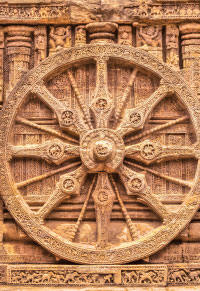சக்தி
விகடன்
Sakthi Vikatan - 26 Apr, 2016
மனசெல்லாம்
மந்திரம்!
– 1 Mind Replete with Mantra
Mantra is just not only for prosperity but also for release from life’s
problems, a blessed device discovered and propagated by Mahaṛṣis.
Mantra chanting is Mantra Yogam. Its greatness is that it makes us
great. If used wrongly, it abandons us. Only the deserving has the right
to using Mantra. It is too important to trifle with. It is essential to
receive a Mantra with instructions from a Guru.
Nāda Braḥmam originates from the heart. That is where the Munis hear the
voice of God. It is the Anāhata Chakra. The Munis with the power of
Tapas can hear the utterances of 90 million Devās. To communicate with a
Devata, there is a need for a deity-specific Mantra. The Munis
discovered the deity-specific Mantras and blessed us with the revelation
with instructions of Mantras to us.
There are strict guidelines for the enunciation of Mantras. Gurunāthar’s
instructions help us in their proper enunciation and using
deity-specific Mantras designed for a specific purpose.
The cornerstones of Mantra meditation and worship are
purpose-specific, deity-specific and mantra-specific, which can be
revealed only by a qualified Gurunāthar to a qualified candidate or
disciple.
Once the Mantra instructions are
received from the Guru, prayer and meditation of the mantra are done
with devotion and Pūja-specific activities. The deity should be invoked
to be present in the object of worship with due attention to rites and
rituals and mantra recitation. These procedures ensure obtaining the
deserved fruits. Mere nominal and mechanical recitation of Mantra
obtain no fruits.
Mantra is like a seed. The bed for the seed (or the sapling) should be
meticulously prepared and then the seed is sown or the sapling is
planted. Before the Guru offers the Mantra, he investigates and
determines the aptitude and the suitability of the candidate, the
favorability of his mental disposition along with receptivity and the
utility of his instructions for him to obtain fruits.
No one can tell with certainty when and where these Mantras came into
being. There are no known authors of these Mantras. The Mantras remained
pervasive in the wide space of the universe. The Mahaṛṣis discovered
them.
These Mantras are revealed in the divine language, the Sanskrit for the
benefit and nobility of humanity. Sanskrit originated from the sound of
the hour-glass drum of Siva.
Once, the Ṛṣis, the travelers of the many worlds, went to the world of
Devas who had no disabilities like grey hair, wrinkled skin and old age.
The Ṛṣis noticed they were the eternals. They desired all of humanity
should live with no problems.
All joined and went to the omnipotent Paramēṣvara and offered their
homage and worship. Paramēṣvara accepted the plea of the Ṛṣis.
Inexorable Time passed. Expecting Paramēṣvara’s grace, the Ṛṣis
performed their rites and rituals.
On the auspicious day of Śivarātri in the evening, Śiva danced. He
sounded seven notes from his hand-held hourglass drum.
The mind-born sons of Brahma, having not heard before of the fourteen
notes, saved them.
They are the Mahēṣa Sūtram of 51 alphabets or letters of the Sanskrit
language. The Sanskritic Mantras remained pervasive in the outer space
of the universe.
Yāskar Ṛṣi wrote the explanation or etymology of Mantras.
மனனம்
விஸ்வ
விக்ஞானம்
த்ராணம்
சம்சார
பந்தனாத்
யத:
கரோதி
ஸம்ஸித்திம்
மந்த்ர
மித்யுச்யதே
ததா:

Mantra, Śabda Pratīkam (Sound as a limb or an accessory), is a
repetitious mental exercise to obtain freedom from bonds, remedial
relief from the miseries of birth and death of the metempsychic ocean,
and offers intellect, perception and realization.
Many Ṛṣis took their birth in Bhārata Dēsam (India) the Karmabhūmi
(India where people live and work) and gave us the beneficial Mantras
floating in the wide spaces of the universe.
Bhāratam states our country had 48,000 Ṛṣi Gaṇas. They are threefold:
Devaṛṣis, Brahmaṛṣis and Rājaṛṣis. Their greatness is their modesty and
self-control.
Ten Ṛṣis in the forefront are Atri, Bhṛgu, Kutsa, Vasiṣtha, Goudamar,
Āngirasar, Bhāradvāja, Viśvāmitrar, Kashyapa, and Jamadagni. They
blessed us with the Mantras and the Missile sciences, having been
witnessed by them.
The 1958 book titled Aṣta Lakṣmi Vilāsam in its 4th chapter
has the heading, ‘Maṇi, Mantra, Auṣada Methods.’
Ṛṣis gave us the Mantras. Every Mantra has its own guidelines. The
aspirants should seek an accomplished Guru to learn the Dos and Don’ts
to attain fruits from Mantra Japam.
These Dos and Don’ts are easy.
Don’t
get discouraged.
These are easy Mantras that ordinary people can recite to obtain
benefits.
To be Continued

